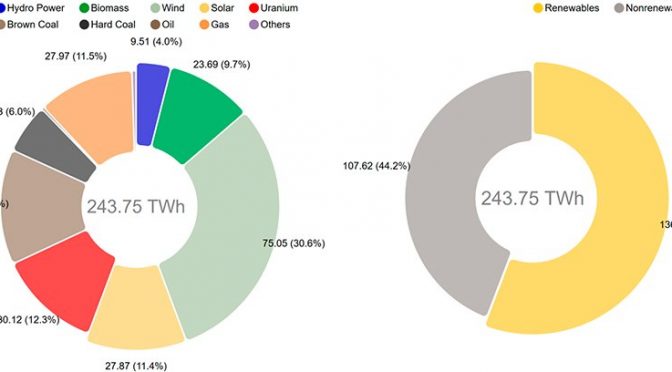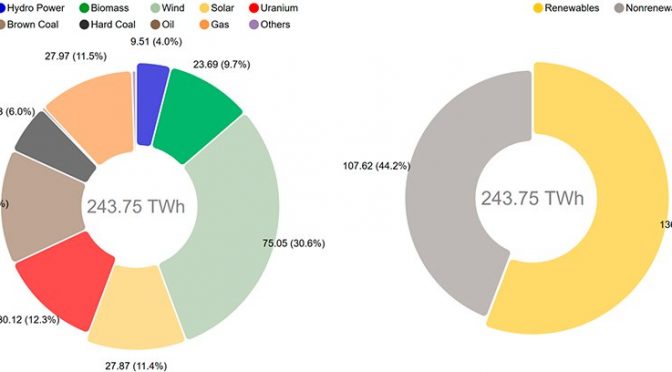German renewable energies reach 55.8% of net generation for the first half of 2020, thanks to wind turbines and solar energy.
Renewable energies accounted for 55.8 percent of Germany’s net electricity generation during the first half of 2020, according to new figures released on Wednesday by the Fraunhofer Institute for Solar Energy Systems (ISE).
The record first half of 2020 included a new high monthly record of 61.8% renewable energy, set in February.
Wind power generated approximately 75TWh in the first half of 2020, about 11.7% above that recorded a year earlier, and during February, largely due to numerous winter storms, its share of net generation of electricity increased to 45%.
German solar electricity generation increased 11.2% to 27.9 TWh compared to 25.1TWH the previous year, while hydroelectric production decreased 9% to 9.5 TWh.
Taken together, renewable sources of wind, solar, hydro and biomass power generated approximately 136.1 TWh of electricity in the first half of 2020 compared to 125.6 TWh a year earlier.

In contrast, both nuclear and coal generation saw their share of the total decline dramatically, with a nuclear fall of 12.9%, while Germany’s two forms of coal generation, brown coal power plants and coal power plants saw their shares drop 36.3% and 45% respectively.
Fraunhofer ISE explained the “sharp drop” in coal noting “the increase in the price of CO? certificates, which averaged 21.91 Euro / t-CO?, as well as the sharp drop in the daily price of exchange electricity from 22, 94 Euro / MWh on average. “
Natural gas power plants increased their production by 13.9% in the first half of 2020 thanks to a number of reasons including the global change in coal, a gigantic drop in natural gas prices, which fell by around a 50%, and the fact that natural gas power plants have lower CO? certificate prices.
The mining and manufacturing industries are now also generating their own electricity from natural gas power plants, which produced an additional 20TWh for the industrial needs of the companies themselves.
Fraunhofer ISE keeps a close eye on Germany’s electricity generation through its Energy Charts platform and announced on Wednesday that Germany’s renewable energy sector set a new generation record.
During the first six months of 2020, renewable energy dominated. Solar and wind power generation contributed a total of 102.9TWh to Germany’s public power grid, 11.5% more than in the same six months a year ago. Wind power was particularly dominant in the German electricity grid, generating 30.6% of the total net electricity generated.
In contrast, coal-fired power generation fell dramatically in the same period, with the proportion of electricity generated by lignite falling to 13.7% and coal to just 6%.
Germany’s new electricity generation paradigm was definitely affected by the global COVID-19 pandemic, with “markedly lower demand for electricity” as of the second quarter “due to declining industrial production,” according to Fraunhofer ISE. .
For example, electricity consumption fell to just 35.3 TWh in June 2020, 6% less than the 37.6 TWh recorded in June 2019. Electricity production decreased similarly, falling from 47.9 TWh in January at 25% to 36 TWh in June.
Collectively, electricity consumption during the first six months of 2020 was just 234.2 TWh, a dramatic 5% drop from 245.7 TWh recorded during the first six months of 2019. Electricity production in the same period fell 8% from 265.5 TWh in the first six months of 2019 fell 21.7 TWh to 243, 8 TWh in the first six months of 2020.
Despite such dramatic drops in both consumption and production, renewable electricity generation, however, grew, resulting in fossil fuel generation, which was the worst part of the decline.


